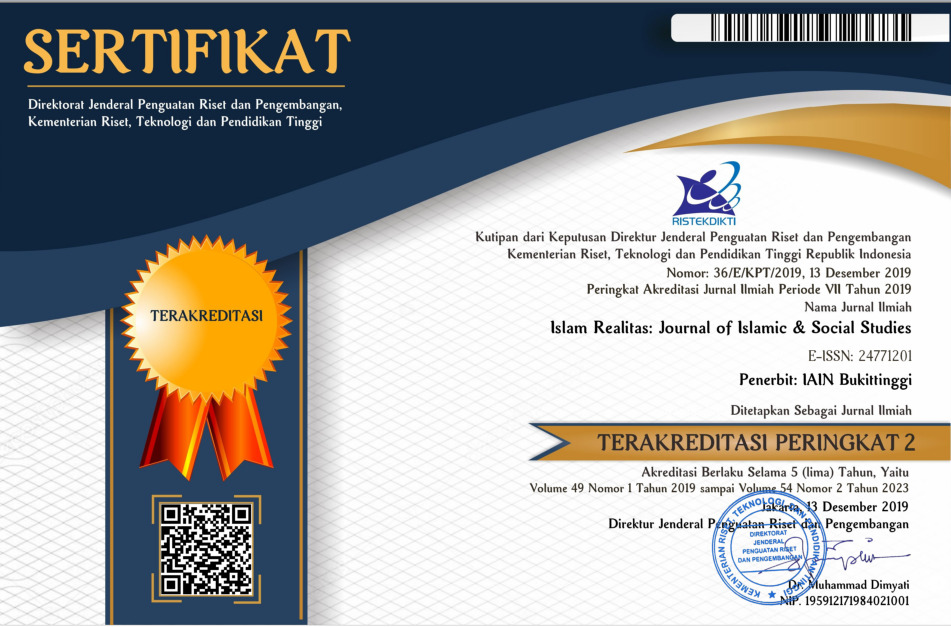Adaptation of Popular Culture in Digital Fatwa on Social Media
Downloads
The development of modern information technology and mass education does not necessarily weaken traditional religious authorities such as Habib. One of Habib's efforts to survive amidst the development of contemporary information technology is to deliver fatwas with popular culture. Fatwa is the main channel for Habib to establish and strengthen his authority. This article examines the adaptation of popular culture in digital fatwas on social media. This study uses a qualitative method. The data collection technique was carried out through netnography. Then, the data was analyzed using thematic analysis. The results of this research show that there are several forms of adaptation of popular culture carried out by Habib Husein Ja'far in conveying his fatwa on social media. First, Habib Husein Ja'far adapted slang language in conveying his fatwa on social media. Second, Habib Husein Ja'far adopted Japanese culture. Third, Habib Husein Ja'far visualized his fatwa in modern comics. Based on these findings, this study concludes that the development of modern technology has provided opportunities for habib to deliver their fatwas digitally. The form of the fatwa delivered by Habib adopts the form of popular culture, thereby attracting the attention of modern young Muslims.
Perkembangan teknologi informasi modern dan pendidikan massal tidak lantas melemahkan otoritas keagamaan tradisional seperti habib. Salah satu upaya yang dilakukan habib untuk bertahan di tengah perkembangan teknologi informasi modern adalah dengan mengemas fatwa melalui budaya populer. Fatwa menjadi saluran utama bagi seorang habib untuk membentuk dan menguatkan otoritasnya. Artikel ini bertujuan untuk mengkaji adaptasi budaya populer dalam fatwa digital di media sosial. Penelitian ini menggunakan metode kualitatif. Adapun teknik pengumpulan data dilakukan melalui netnografi. Kemudian data dianalisis menggunakan analisis tematik. Hasil penelitian ini menunjukkan bahwa ada beberapa bentuk adaptasi budaya populer yang dilakukan Habib Husein Ja’far dalam menyampaikan fatwanya di media sosial yaitu: Pertama, Habib Husein Ja’far mengadaptasi bahasa slang dalam menyampaikan fatwanya di media sosial. Kedua, Habib Husein Ja’far mengadaptasi budaya Jepang. Ketiga, Habib Husein Ja’far memvisualisasikan fatwanya ke dalam komik modern. Berdasarkan temuan tersebut, penelitian ini menyimpulkan bahwa perkembangan teknologi modern telah memberikan peluang kepada habib untuk menyampaikan fatwanya secara digital. Bentuk fatwa yang disampaikan oleh habib mengadopsi bentuk budaya populer, sehingga menarik perhatian anak muda Muslim modern.
Books
Akmaliah, Wahyudi, ‘The Rise of Cool Ustadz: Preaching, Subcultures, and the Pemuda Hijrah Movement’, in The New Santri: Challenges to Traditional Religious Authority in Indonesiahallenges to Traditional Religious Authority in Indonesia, ed. by Norshahril Saat and Ahmad Najib Burhani (Singapore: ISEAS Publishing, 2020), pp. 239–57
Assyaukanie, L, ‘Fatwa and. Violence in Indonesia’, Journal of Religion and Society, 11 (2009), 1-21.
Bayat, Asef, ‘The Coming of a Post-Islamist Society, Critique’, Critique: Journal for Critical Studies of the Middle East, 5.9 (1996), 43–52
Creswell, John W., Research Design: Qualitative, Quantitative, and Mixed Method Approaches, 4th edn (California: SAGE Publications, 2014)
Bunt, Gary R. Islam in the Digital Age: E-Jihad, Online Fatwas and Cyber Islamic Environments (London: Pluto Press, 2003).
Eriyanto, Metode Netnografi: Pendekatan Kualitatif Dalam Memahami Budaya Pengguna Media Sosial (Bandung: Remaja Rosdakarya, 2021)
Esposito, J. L, Ensiklopedi Oxford Dunia Islam Modern (Bandung: Mizan, 2001)
Kompas.com, ‘Suara Para Ulama Soal Polemik Haji Metaverse’, Kompas.Com, 2022
Kompas.id, ‘Tak Masuk Akal, Tetapi Kasus Penggandaan Uang Berulang’, Kompas.Id, 2022
Kozinets, Robert V. Netnography: The Essential Guide to Qualitative Social Media Research (California: SAGE Publications, 2019).
Heryanto, Ariel, IdentIty and Pleasure: The Politics of Indonesian Screen Culture (Japan: Kyoto University Press, 2014)
Journals
Agha, Asif, Language and Social Relations, Cambridge University Press (Cambridge: Cambridge University Press, 2007) <https://doi.org/10.4324/9781315213378-15>
Alatas, Ismail Fajrie, ‘Dreaming Saints: Exploratory Authority and Islamic Praxes of History in Central Java’, Journal of the Royal Anthropological Institute, 26.1 (2020), 67–85 <https://doi.org/10.1111/1467-9655.13177>
Bamualim, Chaider S., dkk., Kaum Muda Muslim Milenial: Konservatisme, Hibridasi Identitas, dan Tantangan Radikalisme (Jakarta: Center for the Study of Religion and Culture (CSRS) UIN Syarif Hidayatullah, 2018), pp. 65-71.
Bazlin, D A T, S Y Teh, and P L Gan, ‘Hijab Styling Is It Fashion or Modesty? Its’ Portrayal in Three Popular Hijab Brands in Malaysia’, International Journal of Modern Trends in Business Research (IJMTBR), 2.7 (2019), 58–65
Beta, Annisa R., ‘Hijabers: How Young Urban Muslim Women Redefine Themselves in Indonesia’, International Communication Gazette, 76.4–5 (2014), 377–89 <https://doi.org/10.1177/1748048514524103>
Braun, Virginia, Victoria Clarke, Nikki Hayfield, and Gareth Terry, ‘Thematic Analysis’, in Handbook of Research Methods in Health Social Sciences, ed. by Pranee Liamputtong (SIngapore: Springer, 2019), pp. 843–60 <https://doi.org/10.1007/978-981-10-5251-4_119>
Brenner, Suzanne, ‘Private Moralities in the Public Sphere: Democratization, Islam, and Gender in Indonesia’, American Anthropologist, 113.3 (2011), 478–90 <https://doi.org/10.1111/j.1548-1433.2010.01355.x>
Budiasa, I Gede, ‘Slang Language in Indonesian Social Media’, Lingual: Journal of Language and Culture, 11.1 (2021), 30 <https://doi.org/10.24843/ljlc.2021.v11.i01.p06>
Burhani, Ahmad Najib, ‘Muslim Televangelists in the Making: Conversion Narratives and the Construction of Religious Authority’, The Muslim World, 110.2 (2020), 154–75 <https://doi.org/10.1111/muwo.12327>
CNN Indonesia, ‘Deret Kasus Dukun Penggandaan Uang, Dimas Kanjeng Hingga Mbah Slamet’, CNN Indonesia, 2022 <https://www.cnnindonesia.com/nasional/20230405163310-12-934041/deret-kasus-dukun-penggandaan-uang-dimas-kanjeng-hingga-mbah-slamet> [accessed 13 October 2023]
———, ‘MUI Respons Khalid: Dulu Sunan Kalijaga Sebarkan Islam Pakai Wayang’, CNN Indonesia, 2022 <https://www.cnnindonesia.com/nasional/20220215133936-20-759394/mui-respons-khalid-dulu-sunan-kalijaga-sebarkan-islam-pakai-wayang> [accessed 13 October 2023]
detik.com, ‘Duduk Perkara Video “Wayang Haram†Khalid Basalamah Dan Kontroversinya’, Detik.Com, 2022 <https://www.detik.com/jateng/berita/d-5943054/duduk-perkara-video-wayang-haram-khalid-basalamah-dan-kontroversinya>
Duraesa, Muhammad Abzar, and Muzayyin Ahyar, ‘Millennial Islamic Proselytizing Movement and Post-Islamism Discourse in Indonesia’, in Millennial Islamic Proselytizing Movement and Post-Islamism Discourse in Indonesia (Mataram, 2021) <https://doi.org/10.2139/ssrn.3767251>
Eickelman, Dale F., and Jon W. Anderson, New Media in the Muslim World: The Emerging Public Sphere (Bloomington: Indiana University Press, 2003)
Eickelman, Dale F., and James Piscatori, Muslim Politics, Islam, State and Society in Indonesia (Prince: Princeton University Press, 2004) <https://doi.org/10.4324/9781315473697-3>
Fitriansyah, Nuzul, ‘Cultivating Online Fun Fatwa in Contemporary Indonesia: Millenial, Piety, and New Religious Authority’, Religio: Jurnal Studi Agama-Agama, 13.1 (2023), pp. 117-135.
Han, Muhamad Ibtissam, ‘Anak Muda, Dakwah Jalanan Dan Fragmentasi Otoritas Keagamaan: Studi Atas Gerakan Dakwah Pemuda Hijrah Dan Pemuda Hidayah’ (UIN Sunan Kalijaga Yogyakarta, 2018)
Hosen, Nadirsyah, ‘Online Fatwa in Indonesia: From Fatwa Shopping to Googling a Kiai’, in Expressing Islam: Religious Life and Politics in Indonesia, ed. by Greg Fealy and Sally White (Singapore: ISEAS Publishing, 2008), pp. 159–73 <https://doi.org/10.1355/9789812308528-017>
Howell, Julia Day, ‘“Calling†and “Trainingâ€: Role Innovation and Religious de-Differentiation in Commercialised Indonesian Islam’, Journal of Contemporary Religion, 28.3 (2013), 401–19 <https://doi.org/10.1080/13537903.2013.831650>
Petersen, Jakob Skovgaard, ‘A Typology of Fatwas’, Die Welt Des Islams, 55 (2015), 278-285.
Jeong, Jae Seon, Seul Hi Lee, and Sang Gil Lee, ‘When Indonesians Routinely Consume Korean Pop Culture: Revisiting Jakartan Fans of the Korean Drama Dae Jang Geum’, International Journal of Communication, 11 (2017), 2288–2307
Kailani, Najib, ‘Forum Lingkar Pena and Muslim Youth in Contemporary Indonesia’, 46.1 (2012), 33–53
———, ‘Kepanikan Moral Dan Dakwah Islam Populer (Membaca Fenomena “Rohis†Di Indonesia)’, Analisis: Jurnal Studi Keislaman, 11.1 (2011), 1–16 <http://ejournal.radenintan.ac.id/index.php/analisis/article/view/604>
———, ‘Muslimising Indonesian Youths: The Tarbiyah Moral and Cultural Movement in Contemporary Indonesia’, in Islam and the 2009 Indonesian Elections, Political and Cultural Issues: The Case of Prosperous Justice Party, ed. by Remy Madinier (Bangkok: IRASEC, 2010), pp. 71–96
Kailani, Najib, and Sunarwoto, ‘Televangelisme Islam Dalam Lanskap Otoritas Keagamaan Baru’, in Ulama Dan Negara Bangsa: Membaca Masa Depan Islam Politik Di Indonesia, ed. by Noorhaidi Hasan (Yogyakarta: Pusat Pengkajian Islam, Demokrasi, dan Perdamaian (PusPIDeP), 2019), pp. 179–206
Kaptein, Nico J.G., ‘The Voice of the “UlamÇŽâ€: Fatwas and Religious Authority in Indonesia’, Archives de Sciences Sociales Des Religions, 125.1 (2004), 115–30 <https://doi.org/10.4000/assr.1038>
Kaptein, Nico, ‘Fatwas as a unifying Factor in Indonesian History’, in Islam in the Era of Globalization ed. by Johan Meuleman (London and New York: Routledge, 2002), pp. 72-78
Mandal, Sumit K., ‘An Arab Indonesian Singing Preacher, an Islamic Mass Concert, and the Historic Capture of a Public Space in Malaysia’, Asian Studies Review, 2022, 10357823 <https://doi.org/10.1080/10357823.2022.2131734>
Masud, Muhammad Khalid, Brinkley Messick, and David S. Powers, ‘Muftis, Fatwas, and Islamic Legal Interpretation’, in Islamic Legal Interpretation: Muftis and Their Fatwas, ed. by Muhammad Khalid Masud, Brinkley Messick, and David S. Powers (London: Harvard University Press, 1996), pp. 3–32 <https://doi.org/10.2307/2654817>
Masud, Muhammad Khalid, ‘Fatwa Advice on Proper Muslim Names’, in Islam in South Asia: In Practice, ed. by Barbara D. Metcalf (Princeton & Oxford: Princeton University Press, 2009), pp. 339-351.
Millie, Julian, ‘Oratorical Innovation and Audience Heterogeneity in Islamic West Java’, Indonesia, 93 (2012), 123–45
———, ‘The Languages of Preaching: Code Selection in Sundanese Islamic Oratory, West Java’, Australian Journal of Anthropology (The), 23.3 (2012), 379–97 <https://doi.org/10.1111/taja.12006>
Najamudin, Atho’ilah Aly, and Irwan Abdullah, ‘Habib, Islam, Dan Otoritas Keagamaan: Penerimaan Masyarakat Muslim Banyuwangi’, Farabi, 19.1 (2022), 16–48 <https://journal.iaingorontalo.ac.id/index.php/fa/article/view/2539%0Ahttps://journal.iaingorontalo.ac.id/index.php/fa/article/download/2539/1429>
Ng, Tuen Man, and Chung Shing Chan, ‘Investigating Film-Induced Tourism Potential: The Influence of Korean TV Dramas on Hong Kong Young Adults’, Asian Geographer, 37.1 (2020), 53–73 <https://doi.org/10.1080/10225706.2019.1701506>
Putra, Novi Pradhana, Bambang Sunarto, and Dharsono, ‘Indonesian Islamic Comic Development’, 5th Bandung Creative Movement International Conference on Creative Industries 2018 (5th BCM 2018), 197 (2019), 346–54
Putri, Vandani Kencana, and Matthias Reese, ‘The Impact of “Korean Wave†on Young Indonesian Females and Indonesia Culture in Jabodetabek Area’, Business and Management Studies Journal, 3.2 (2016), 35–53
Rijal, Syamsul, ‘Kaum Muda Pecinta Habaib: Kesalehan Populer Dan Ekspresi Anak Muda Di Ibu Kota’, Afkaruna, 14.2 (2018), 166–219 <https://doi.org/10.18196/aiijis.2018.0086.166-189>
———, ‘Performing Arab Saints and Marketing the Prophet: Habaib and Islamic Markets in Contemporary Indonesia’, Archipel, 99, 2020, 189–213 <https://doi.org/10.4000/archipel.1719>
Rosidi, Imron, Being Active Consumers: Indonesian Muslim Youth Engaging with Korean Television Dramas (Gadong, 2016)
Rosidi, Imron, and Khotimah, ‘Negotiating Representation of Islamic Values on Korean TV Dramas Among Indonesian Muslim Youth’, Jurnal Komunikasi: Malaysian Journal of Communication, 36.4 (2020), 230–42 <https://doi.org/10.17576/JKMJC-2020-3604-14>
Ryoo, Woongjae, ‘Globalization, or the Logic of Cultural Hybridization: The Case of the Korean Wave’, Asian Journal of Communication, 19.2 (2009), 137–51 <https://doi.org/10.1080/01292980902826427>
Soenarto, Ermita, ‘From Saints to Superheroes: The Wali Songo Myth in Contemporary Indonesia’s Popular Genres’, Journal of the Malaysian Branch of the Royal Asiatic Society, 2005, 33–82
———, ‘Making Sense of the Past & Present: Islamic Comic Books in Indonesia, 1965 - 2007’ (NUS, 2009) <https://scholarbank.nus.edu.sg/handle/10635/15945>
Suaedy, Ahmad, et.al., ‘Language, Authority, and Digital Media: The Impact on the Legitimacy of Fatwas’, Ahkam, 23.1 (2023), 1-24.
Triantoro, Dony Arung, ‘D’rise Magazine: Between The Piety, Popular Culture And Ideology’, Ulum Islamiyyah, 25 (2018), 31–40 <https://doi.org/10.33102/uij.vol25no0.134>
———, Ustaz Abdul Somad Ustaz Karismatik Dunia Digital (Yogyakarta: Diandra Kreatif dan Omah Ilmu Publishing, 2019)
Turner, Bryan S., ‘Religious Authority and the New Media’, Theory, Culture & Society, 24.2 (2007), 117–34 <https://doi.org/10.1177/0263276407075001>
Turner, Graeme, ‘After Hybridity: Muslim-Australians and the Imagined Community’, Continuum, 17.4 (2003), 411–18 <https://doi.org/10.1080/1030431032000151998>
Watson, C. W., ‘A Popular Indonesian Preacher: The Significance of Aa Gymnastiar’, Journal of the Royal Anthropological Institute, 11.4 (2005), 773–92 <https://doi.org/10.1111/j.1467-9655.2005.00261.x>
Woodward, Mark, Inayah Rohmaniyah, Ali Amin, Samsul Ma’arif, Diana Murtaugh Coleman, and Muhammad Sani Umar, ‘Ordering What Is Right, Forbidding What Is Wrong: Two Faces of Hadhrami Dakwah in Contemporary Indonesia’, RIMA: Review of Indonesian and Malaysian Affairs, 46.2 (2012), 105–46
Authors who publish with this journal agree to the following terms:
- Authors retain copyright and grant the journal right of first publication with the work simultaneously licensed under a Creative Commons Attribution License that allows others to share the work with an acknowledgment of the work's authorship and initial publication in this journal.
- Authors are able to enter into separate, additional contractual arrangements for the non-exclusive distribution of the journal's published version of the work (e.g., post it to an institutional repository or publish it in a book), with an acknowledgment of its initial publication in this journal.
- Authors are permitted and encouraged to post their work online (e.g., in institutional repositories or on their website) prior to and during the submission process, as it can lead to productive exchanges, as well as earlier and greater citation of published work (See The Effect of Open Access).









